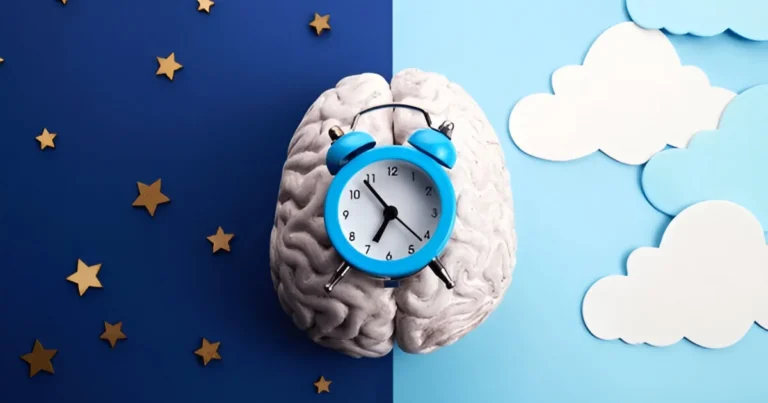Dreaming up solutions: The brain’s hidden creative mode
Why do some ideas only emerge after a break, as if inactivity were the brain’s hidden engine? This question, though far from new, touches on one of the most subtle and profound mechanisms of human cognition. For decades, neuroscience has explored the hypothesis that disengagement, or even sleep, might allow the brain to process information differently: not linearly, but by weaving more flexible, distant connections between previously isolated pieces of knowledge. Rather than shutting down, the sleeping brain continues to elaborate, reorganize, and occasionally even discover, at its own pace, beyond the bounds of conscious control.
History is full of breakthroughs born not from relentless effort but from the loosened grip of sleep. Take Dmitri Mendeleev, for example. After weeks of trying to organize the elements, he claimed to have dreamt of the periodic table as he would later publish it. “I saw in a dream a table where all the elements fell into place,” he wrote. What logic and wakefulness had failed to provide, sleep revealed through a reorganized vision, an intuitive order emerging beyond conscious reasoning.
Among the processes at play in this quiet dynamic, analogical reasoning stands out. It’s not a matter of superficial comparison, but a sophisticated mental operation that enables us to apply a known structure to a new problem. It’s a structured form of intuition, one that detects deep similarities beneath surface differences. A rare and valuable skill, but one that is difficult to summon deliberately. This raises a compelling question: could sleep, especially napping, enhance our ability to connect ideas that normally escape our attention while awake?
To investigate, researchers at the University of Texas examined the effects of sleep on solving analogical problems. Their study is part of a broader exploration into how the brain breaks free from habitual pathways, reshaping mental representations and uncovering solutions where none seemed possible just hours before.
🔗 Read also: Heat and Hypnagogia: How summer alters brain function
Solving in sleep: A matter of hidden links
In a 2024 study, Westerberg and colleagues tested whether a nap could help participants transfer a known solution to a structurally similar but differently framed problem. They recruited 58 students aged 18 to 29, randomly assigning them to either a 90-minute nap or a 2-hour wakeful break.
Before the break, participants were presented with eight “source problems” designed to engage different types of reasoning. After three minutes of reflection, each problem’s solution was revealed. They then encountered eight “target problems” that shared structural similarities but were disguised in form. Only those left unsolved were carried over to a second attempt after the break.
During the nap, participants were monitored via EEG to track sleep phases, especially REM sleep. After the break, they resumed the task: solving the unsolved problems, rating perceived similarity between problems, and completing a memory test on the earlier solutions.
Results revealed a sharp contrast. Before the break, performance was similar across groups. Afterward, nappers solved 43% of previously unsolved problems, while non-nappers managed only 15%. This improvement wasn’t due to better memory, both groups recalled seven out of eight solutions, nor greater alertness. The key variable was REM sleep: the more time participants spent in this phase, the better they recognized hidden relationships, even when surface features changed.
This supports a central idea in cognitive neuroscience: sleep doesn’t just strengthen existing memories, it restructures information. It reshapes connections, fosters new associations, and allows access to links that remain hidden during wakefulness. Some theories suggest that memories consolidated during slow-wave sleep are later reactivated in REM sleep, in a partially random fashion, enabling creative recombinations. REM sleep appears to encourage exploration of weak connections often ignored by conscious thought. In both cases, it’s the freedom from cognitive constraints that allows the brain to detect novel forms of organization in what initially appears chaotic.
🔗 Explore further: Creativity: A flash of rebellious brilliance
Dream logic: How sleep unlocks innovation
This cognitive power of sleep isn’t just theoretical. The history of science and art offers numerous cases where sleep granted access to forms of invention beyond conscious reasoning.
Friedrich August Kekulé famously dreamed of a snake biting its tail, an image that led him to the concept of a closed ring in the benzene molecule, revolutionizing organic chemistry. It was a crystallization of deep scientific inquiry that sleep helped shape. A century later, in an entirely different field, Paul McCartney recounted dreaming the complete melody of “Yesterday,” convinced he had simply recalled a song he’d heard elsewhere. Upon checking and finding no such song existed, he realized his dreaming brain had composed it. What his waking mind hadn’t managed, his sleeping brain orchestrated, and it became one of the most covered songs in music history.
These stories echo what neuropsychology is beginning to formalize. While slow-wave sleep (particularly stages 2 and 3) is crucial for stabilizing explicit memories, REM sleep promotes associative flexibility, a key ingredient for cognitive creativity. REM sleep creates fertile ground for distant idea associations, hidden pattern detection, and the temporary suspension of usual logical filters. It’s not about losing control but loosening it, allowing alternative connections to emerge. In these moments of relaxation, the brain shifts from analyst to explorer, mapping unsuspected relationships.
This functional decoupling suggests that sleep isn’t a uniform state, but a sequence of complementary modules, each playing a unique role in information processing. In moments of mental block, even a short nap including REM sleep may reignite thought, not by adding data, but by offering a new perspective on what’s already there.
🔗 Discover more: Sleepless Nights: How sleep deprivation strengthens unwanted memories
Sleep: the silent laboratory of thought
All these findings point to one conclusion: sleep acts as a silent laboratory for the mind. It doesn’t halt thought, it changes its logic. In this fertile mental terrain, knowledge reorganizes, hidden links emerge, and familiar material transforms into something new. Conscious effort steps aside, making room for a more fluid form of elaboration, one that reveals solutions consciousness alone can’t always reach.
In this suspended space, thought breaks free from immediate constraints to explore paths unreachable by conscious effort. And perhaps it’s here, in the quiet shadow of the sleeping brain, that some of our most powerful ideas are born.
References
Beijamini, F., Pereira, S. I., Cini, F. A., & Louzada, F. M. (2014). After being challenged by a video game problem, sleep increases the chance to solve it. PLoS ONE, 9(1), e84342.
Lewis, P. A., Knoblich, G., & Poe, G. (2018). How memory replay in sleep boosts creative problem-solving. Trends in Cognitive Sciences, 22(6), 491–503.
Westerberg, C. E., Fickle, S. E., Troupe, C. E., Madden-Rusnak, A., & Deason, R. G. (2024). An afternoon nap facilitates analogical transfer in creative problem solving. Journal of Sleep Research, e14419.
Zadra, A., & Stickgold, R. (2021). When brains dream: Exploring the science and mystery of sleep. W.W. Norton & Company.

Sara Lakehayli
PhD, Clinical Neuroscience & Mental Health
Associate member of the Laboratory for Nervous System Diseases, Neurosensory Disorders, and Disability, Faculty of Medicine and Pharmacy of Casablanca
Professor, Higher School of Psychology







